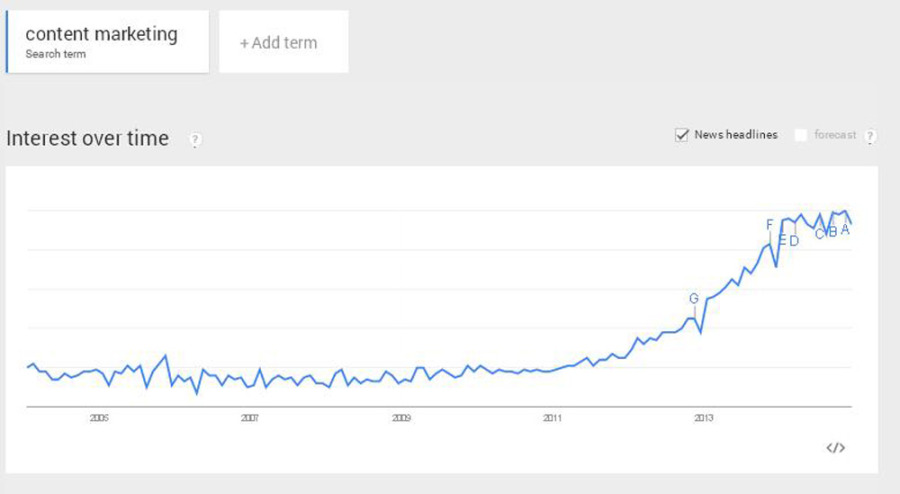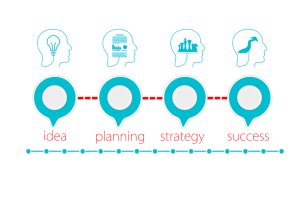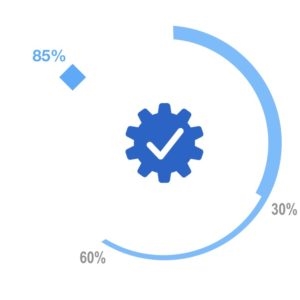
Another year in the evolution of digital marketing has come and gone. Some former best practices have fallen by the wayside, some strategies that would’ve been considered absolutely essential 12 months ago have now died, drifting off to the virtual graveyard in the clouds. The decline of organic reach on Facebook, the continued rise of video content, the death of Google authorship – so much can change within the space of 52 weeks. And now we’re looking forward, predicting what’s on the horizon for the future of digital marketing, what trends brands should be watching for in 2015. So where should you be looking? What new skills should you be boning up on in anticipation of the next big shift? Here are three things to consider in your marketing planning for the new year.
1. Content marketing will remain a big focus
2014 was the year that content marketing came to the fore, became the thing that all businesses needed to be taking more seriously. It started in mid-2013, when Google released their ‘Hummingbird’ algorithm update, which, combined with the ongoing ‘Panda‘ refinements, put an increased emphasis on content ‘quality’ over keywords and traditional SEO staples. While those elements are still required, the systems are getting smarter and are able allocate search rank using more functional data points, further reinforcing that the best way to rank well in Google is to have content that is highly shared and highly referenced – user activity signals that Google can use to determine relevance and authority.

Searches for ‘content marketing’ over time – via Google Trends
Given this, the emphasis on content isn’t likely to die out anytime soon, but the focus of creation process is likely to change. While the push thus far has been on creation and the importance of establishing a content process, the next 12 months will see a honing in on the quality aspect and the functional elements required to achieve it.
The steady rise of online content has also necessitated the development of more measures to help filter the flood of data and guide users to the material most relevant to them and their queries. The most prevalent examples of this have been Google’s constant algorithm updates and Facebook’s News Feed changes which have strangled organic reach. As described by Facebook, with so many posts coming in everyday, they’ve made changes to ensure the most relevant and important updates are highlighted to each user, relative to their historic preferences. This also means that if brands want to maintain any level of reach, they need to start listening in and providing what their fans want. The onus has clearly been placed on brands to provide highly relevant content, content that compels sharing, re-posting and discussion, content that is, by nature, ‘social’, that’s part of the community conversation. While online platforms can reduce non-paid reach to better rationalise the rising content flood, highly shared material will always still stand out from the pack and continue to perform well – the algorithms are designed to show users the content of highest relevance, meaning you need yours to be that.
The good news is we have access to a whole range of data that can guide us towards what our audience wants. Through the increased use of social media, our target customers are leaving data trails for us to find all over the web. Sorting the message from the noise will become a big focus, as locating that data – finding those nuggets of gold within the big data mine – will enable brands to create better content, make more informed marketing decisions and will help build community relationships that translate to actual results. Content is crucial in the online world, and increasingly, the online world is where your audience is at. By tuning-in and being receptive to what your potential customers are saying, you have the opportunity to target your efforts, moreso than any other time in history. Creating high-quality, better targeted, niche-specific material will be the next focus of the content movement. Because in a world where everyone’s putting out blog posts and videos and infographics, doing the same as the rest won’t be enough to break from the pack.
2. Video content will continue to rise
At Facebook’s recent third quarter earnings call, CEO Mark Zuckerberg talked up the continued rise of video content on the platform, which has it set to overtake YouTube in terms of overall video consumption in the very near future. Zuckerberg said that he expects the amount of video posted on the platform to continue to rise over the next few years – and you can already see it going this way, the introduction of auto-play video has fundamentally changed the Facebook news feed. While there have been some complaints about the increase in video content, the emphasis on video is likely to remain a key focus in 2015 for one big reason – the ALS Ice Bucket Challenge.
The Ice Bucket Challenge was one of the biggest sensations of 2014, generating billions of clicks and raising more than $ 119 million dollars for amyotrophic lateral sclerosis research. One of the most resonant aspects of the campaign was video, that people could participate and share their own experiences quickly and easily. That access is something that needs to be considered in the rise of video content – it used to be that you needed expensive equipment and a production budget to produce quality video work. These days, anyone can produce a reasonable quality film using the camera on their iPhone and the many video apps you can access online. Vine’s 6-second approach has also played a part in the rising popularity of video content – seeing what’s possible in 6 seconds, a growing number of users are experimenting, seeing what they can do. Harnessing that enthusiasm for the medium to facilitate user-generated content can yield massive results in brand reach and recall.
The accessibility of the required tools and the expanding opportunities of creating video content will see more brands focus on UGC-based campaigns in 2015. It’s a smart play and one which works in-line with consumer trends, particularly among younger audiences. Whereas in 2014 the emphasis was on images and on including images wherever possible, video will be where it’s at in the next year. As you go about your content planning, it might be worth factoring in the possibilities of video content and UGC in your campaigns.
3. There’ll be big momentum on employee advocacy and empowering employees to help spread brand messages online
Social media has infinitely expanded the role of word-of-mouth messaging. Whereas once the practice was confined by geography, there are now virtually no limits to how far and wide your message can be spread amongst communities and followers. Given that, the importance of spreading your brand message via word-of-mouth will also play an important role in your overall marketing plan – and who do you have who can help spread that message?
Employee advocacy will become a bigger focus as brands recognise the power of individual voices online. Your employees are best placed to assist in this regard, because they’re the ones putting in the effort everyday to make your business what it is. They know the common questions asked by clients, they understand the consumer perspective and the answers to those FAQs. Smart brands will work to empower their employees to see their ‘9 to 5’ as more than just a job – to see it, also, as something they believe in, the purpose behind their efforts. By enabling your staff to build their industry knowledge and communicate on related topics, you’re not only helping build your brand through their expertise, but you’re also helping them build their personal profile, which can only be beneficial in their longer-term career plans.
Of course, the concern may be that you enable them too much, that they get offered positions elsewhere and leave as a result. But as noted by the great Richard Branson, your aim as employers should be to train your staff well enough so they can leave, while treating them well enough that they wouldn’t want to. A lofty goal for sure, but the benefits of your employees building their personal brands online will reflect in the overall standing of your company as the leader in your field. Imagine if all the top experts in your industry worked for you. Pretty certain that would see the majority of customers coming across your brand name when searching for related info online.
As it is with all industries, change is a constant in the digital marketing sphere – but given the rapid evolution of online technologies, and the rising adoption of social media platforms, the sector is more in-flux than most. It’s important to stay on top of the latest industry trends, to stay in touch with what’s changing, how consumers are consuming media and what they’re saying about your brand. But more import than that, the critical element to consider is what your target audience is doing. There’s little point jumping on the video bandwagon if it’s just not resonating with who you want to reach; there’s no point writing posts about internal company changes if no one’s reading them. It’s important that you do your research and work out the specific details for your communities and understand them, not the overall trends alone. Through the increased adaptation of your own processes to make sense of the rising noise of social platforms, you can build intelligent data centres that hone in and translate the detail that’s of most relevance to your brand.
The above trends are important to consider, as they’ll be important considerations from a wider industry perspective, but the real challenge of 2015 will be to understand how all this new data, all these new platforms, can be best tailored for your benefit. And the best way to start is to learn what’s out there. Then allow the possibilities to expand in your mind.
Digital & Social Articles on Business 2 Community
(575)







